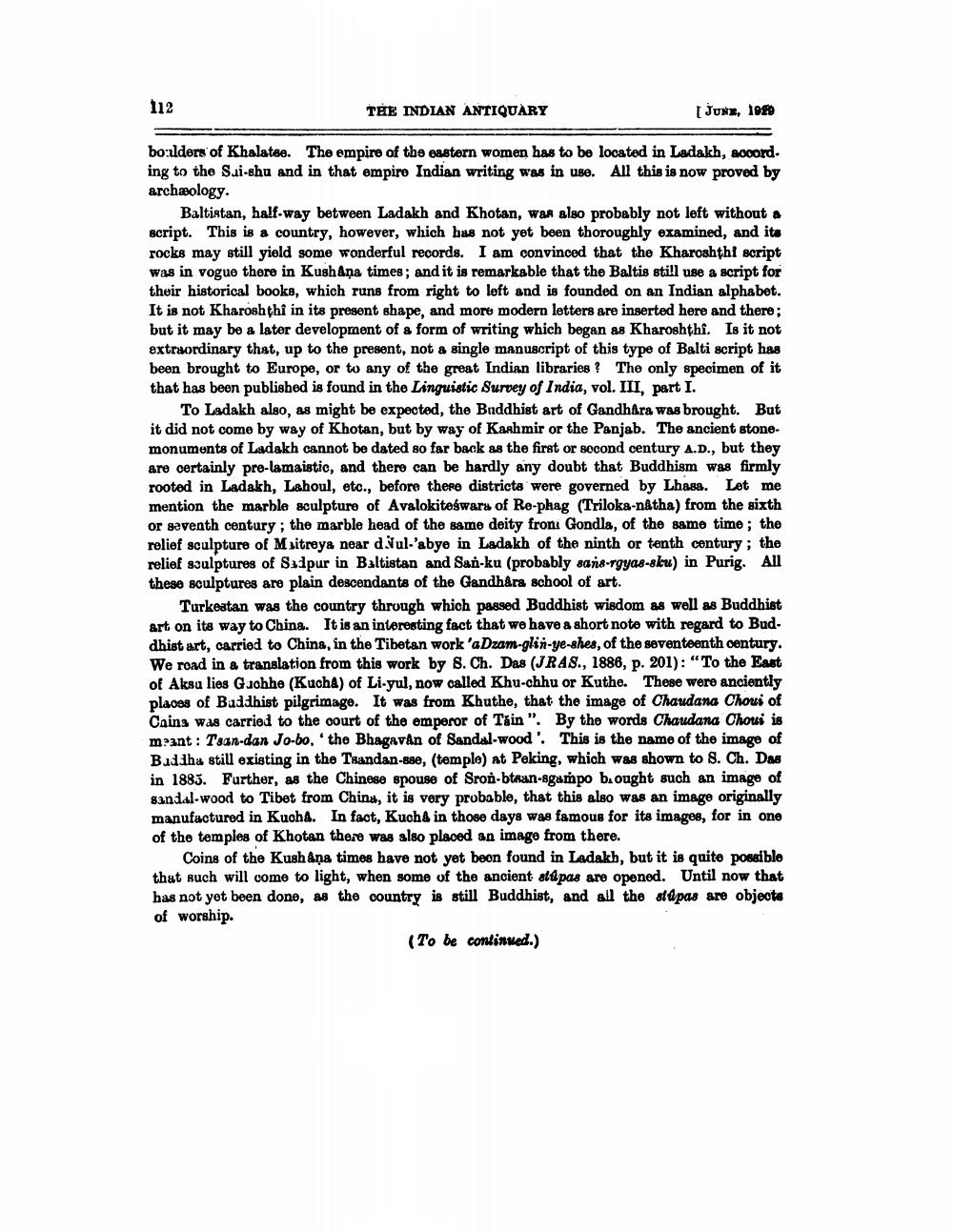________________
112
[JUNE, 1989
boulders of Khalatee. The empire of the eastern women has to be located in Ladakh, accord. ing to the Sui-shu and in that empire Indian writing was in use. All this is now proved by archæology.
THE INDIAN ANTIQUARY
Baltistan, half-way between Ladakh and Khotan, was also probably not left without a script. This is a country, however, which has not yet been thoroughly examined, and its rocks may still yield some wonderful records. I am convinced that the Kharoshthi script was in vogue there in Kushana times; and it is remarkable that the Baltis still use a script for their historical books, which runs from right to left and is founded on an Indian alphabet. It is not Kharosh thî in its present shape, and more modern letters are inserted here and there; but it may be a later development of a form of writing which began as Kharoshthî. Is it not extraordinary that, up to the present, not a single manuscript of this type of Balti script has been brought to Europe, or to any of the great Indian libraries? The only specimen of it that has been published is found in the Linguistic Survey of India, vol. III, part I.
To Ladakh also, as might be expected, the Buddhist art of Gandhara was brought. But it did not come by way of Khotan, but by way of Kashmir or the Panjab. The ancient stonemonuments of Ladakh cannot be dated so far back as the first or second century A.D., but they are certainly pre-lamaistic, and there can be hardly any doubt that Buddhism was firmly rooted in Ladakh, Lahoul, etc., before these districts were governed by Lhasa. Let me mention the marble sculpture of Avalokiteswara of Re-phag (Triloka-natha) from the sixth or seventh century; the marble head of the same deity fron Gondla, of the same time; the relief sculpture of Maitreya near d.Nul-'abye in Ladakh of the ninth or tenth century; the relief sculptures of Sadpur in Baltistan and San-ku (probably sans-rgyas-sku) in Purig. All these sculptures are plain descendants of the Gandhara school of art.
Turkestan was the country through which passed Buddhist wisdom as well as Buddhist art on its way to China. It is an interesting fact that we have a short note with regard to Buddhist art, carried to China, in the Tibetan work 'a Dzam-glin-ye-shes, of the seventeenth century. We road in a translation from this work by S. Ch. Das (JRAS., 1886, p. 201): "To the East of Aksu lies Gachhe (Kucha) of Li-yul, now called Khu-chhu or Kuthe. These were anciently places of Buddhist pilgrimage. It was from Khuthe, that the image of Chaudana Choui of Caina was carried to the court of the emperor of Tain". By the words Chaudana Choui is meant: Tsan-dan Jo-bo, the Bhagavan of Sandal-wood'. This is the name of the image of Buddha still existing in the Tsandan-sse, (temple) at Peking, which was shown to 8. Ch. Das in 1885. Further, as the Chinese spouse of Sron-btaan-sgampo bought such an image of sandal-wood to Tibet from China, it is very probable, that this also was an image originally manufactured in Kucha. In fact, Kucha in those days was famous for its images, for in one of the temples of Khotan there was also placed an image from there.
Coins of the Kushana times have not yet been found in Ladakh, but it is quite possible that such will come to light, when some of the ancient stupas are opened. Until now that has not yet been done, as the country is still Buddhist, and all the stupas are objects of worship.
(To be continued.)




